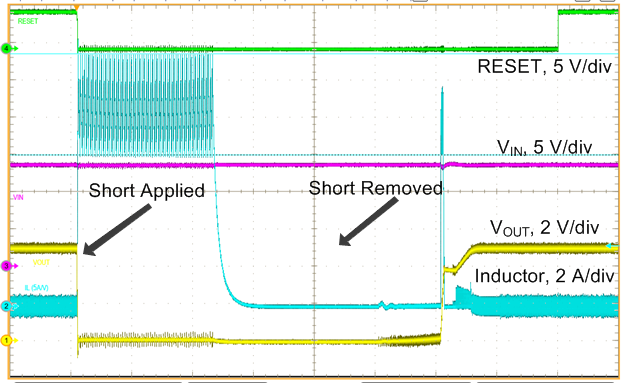ZHCSGY9B July 2017 – March 2018 LMS3655
PRODUCTION DATA.
- 1 特性
- 2 应用
- 3 说明
- 4 修订历史记录
- 5 Device Comparison Table
- 6 Pin Configuration and Functions
- 7 Specifications
- 8 Detailed Description
-
9 Application and Implementation
- 9.1 Application Information
- 9.2
Typical Applications
- 9.2.1 General Application
- 9.2.2 Adjustable 5-V Output
- 9.2.3 Adjustable 3.3-V Output
- 9.2.4 6-V Adjustable Output
- 9.3 Do's and Don't's
- 10Power Supply Recommendations
- 11Layout
- 12器件和文档支持
- 13机械、封装和可订购信息
8.3.4 Current Limit
The LMS3655 incorporates a valley current limit for normal overloads and for short-circuit protection. A precision low-side current limit prevents excessive average output current from the buck converter of the LMS3655. A high-side peak-current limit is employed for protection of the top N MOSFET and inductors. The two current limits enable use of smaller inductors than a system with a single current limit. This scheme allows use of inductors with saturation current rated less than twice the operating current of the LMS3655.
During overloads the low-side current limit, IL-LS (seeElectrical Characteristics), determines the maximum load current that the LMS3655 can supply. When the low-side switch turns on, the inductor current begins to ramp down. If the current does not fall below IL-LS before the next turnon cycle, then that cycle is skipped, and the low-side FET is left on until the current falls below IL-LS. This is different than the more typical peak current limit, and results in Equation 1 for the maximum load current.

If the converter continues triggering valley current limit for more than about 64 clock cycles, the device turns off both high and low side switches for approximately 6 ms (see TW inTiming Requirements). If the overload is still present after the hiccup time, another 64 cycles is counted, and the process is repeated. If the current limit is not tripped for two consecutive clock cycles, the counter is reset. The hiccup time allows the inductor current to fall to zero, resetting the inductor volt-second balance. Of course the output current is greatly reduced in this condition (seeTypical Characteristics). A typical short-circuit transient and recovery is shown in Figure 13.
SPACE
 Figure 13. Short-Circuit Transient and Recovery
Figure 13. Short-Circuit Transient and Recovery
SPACE
The high-side current limit trips when the peak inductor current reaches IL-HS (see Electrical Characteristics). This is a cycle-by-cycle current limit and does not produce any frequency or current foldback. It is meant to protect the high-side MOSFET from excessive current. Under some conditions, such as high input voltage, this current limit may trip before the low-side protection. The peak value of this current limit varies with duty cycle.
In response to a short circuit, the peak current limit prevents excessive peak current while valley current limit prevents excessive average inductor current and keeps the power dissipation low during a fault. After a small number of cycles of valley current limit triggers, hiccup mode is activated.
In addition, the INEG current limit also protects the low-side switch from excessive negative current when the device is in FPWM mode. If this current exceeds INEG, the low-side switch is turned off until the next clock cycle. When the device is in AUTO mode, the negative current limit is increased to about IZC (about 0 A). This allows the device to operate in DCM.